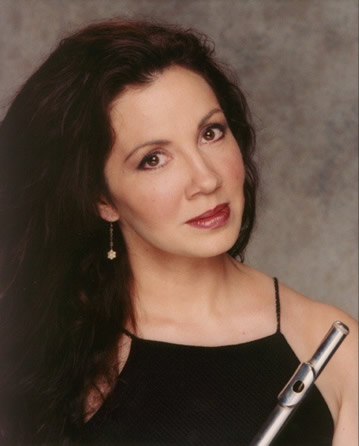Music Director Dmitri Sitkovetsky chose an attractive menu of works entirely by Wolfgang Amadeus Mozart (1756-91) for the Greensboro Symphony Orchestra‘s second Masterworks concert of the season. This series concert returned to its usual venue, the acoustically fine Dana Auditorium on the bucolic campus of Guilford College. The nationally distinguished GSO principal flutist Debra Reuter-Pivetta was the featured concerto soloist.
Mozart’s Die Zauberflöte, K. 620 (1791), was his first full-scale opera in the German language. The composer had joined the banned Freemason Society in 1784, and multiple books and studies have been written about hidden Masonic symbols in the opera. The sacred number of three proliferates throughout the opera and is immediately heard in the three introductory chords that begin the Overture, which opened this concert. The sparkling single theme is treated fugally as it romps its way throughout the various instruments. Mozart may have purloined this theme from Sonata in B-flat, Op. 24, No. 2, by the great keyboard composer Muzio Clementi. The three ominous chords return before the end of the overture, which was composed after the opera had been completed.
Sitkovetsky led a stylish and superbly balanced performance. His seating of the orchestra, with violin sections divided with firsts on stage left and seconds on stage right with violas behind first violins and cellos and double basses behind seconds, repays in clarity for 18th century music. Intonation was excellent and every strand of the score was easily followed. The woodwinds were strongly characterized.
Mozart’s letters to his father record his antipathy for the flute. Perhaps his encounter with the magnificent wind players in the extraordinary virtuoso Mannheim Orchestra in 1777 may have mollified his aversion. Its principal flute was Johann Baptist Wendling who arranged a commission of 200 gulden for four concertos and six quartets for the Dutch amateur flutist Ferdinand de Jean. Mozart failed to complete his commission; only the Concerto No. 1 in G, K. 313, a Second Flute Concerto, K. 314 (a transcription of the Oboe Concerto, K. 271k), and three quartets were finished. He was lucky to receive any funds.
No distaste is evident in his First Flute Concerto, which bubbles with warmth, wit, and instrumental refinement. The Allegro apposes a pompous first subject with a rhythmically arpeggiated codetta. In the second movement, pairs of oboes used in the first movement, are replaced by pairs of flutes that join with muted strings to form a luscious melody that is taken up and spun at length by the soloist. The effusive rondo finale, in the tempo of a minuet, sparkles with high spirits.
Mozart challenges an orchestra’s mettle; he provides no cover at all for mistakes. However, Reuter-Pivetta played magnificently; her interpretation was beautifully phrased. Her seamless breath control was remarkable as was her articulation of fast passages. Her cadenzas gave her plenty of scope to display beautiful tone and agility. Sitkovetsky and his musicians provided ideal support.
Reuter-Pivetta’s encore, a Venezuelan folk dance by Marco Granados called “Heebie Jeebies,” brought the audience to its feet. It abounded with high speed and hairpin virtuosity. Truly breathtaking breath control! Her tour-de-force was rewarded with a prolonged standing ovation.
Symphony No. 39 in E-flat, K. 543 (1788), is performed less often than the other two of the final symphonic trilogy. It lacks the romantic quality of Symphony No. 40 in G minor, K. 550, or the strong name identification of Symphony No. 41 in C, K. 551, “Jupiter.” The No. 39 abounds with masterful scoring and thematic inspiration. An insinuating chromaticism permeates all four movements. A dark, slow introduction leads to a subtle allegro. The Andante is scored with great economy of means. The trio of the courtly Minuet is a distinctive folk-like Ländler. The Finale features a theme, like a trivial contredanse tune, treated with intense harmony which helps boost the movement’s high spirits.
Sitkovetsky led a stirring performance of Symphony No. 39 with well-chosen tempos that allowed the music to breathe. Juxtapositions and blending of themes were extraordinarily clear. The string sections’ intonation was precise and possessed great warmth. The woodwinds played with great individuality. Principal clarinet Kelly Burke brought out the rustic quality of the trio of the Minuetto. The pair of horns, led by principal Robert Campbell, was a constant delight as they had been throughout the evening.
I look forward to more all-classical Mozart evenings, perhaps spiced with Haydn. This repertoire is ideal for polishing the skills of an orchestra.











